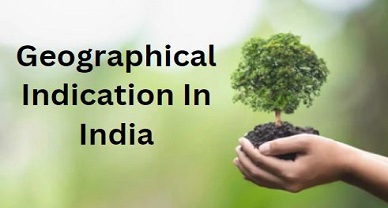Globally Local: Analysing The Impact Of Geographical Indication On International Trade
Geographical Indications, which are essentially territorial in nature, are now losing territorial linkages due to global trade and export. This article seeks to examine the impact and effect of the trade of Geographical Indication around the globe. Dating back to the 19th century French practice, initially used for distinguishing genuine wine from counterfeit product of the same nature, Geographical Indications (‘GI’) are garnering international attention. The reason being its adoption by European Union and gradual inclusion in legislations across states. It has also muddled through a fair amount of global controversy as it was a factor of contention during the establishment of World Trade Organisation (‘WTO’) and further through the Doha Development Agenda where it was a highly negotiated topic but the member nations of the organisation didn’t reach consensus regarding many aspects of Geographical Indications. These negotiations served as an impetus towards propagation and acceptance of Geographical Indications into the folds of Intellectual Property Law regime.
Analysing the “Trade Related Agreements” of “Bilateral and Multilateral” Nature, one would observe the consistent inclusion of GI in most of them. This is primarily due to the impact of European Union (‘EU’) and its active concerted efforts towards propagating a “GI Protection Based Agenda” outside its borders and into the policy of other nations. In the current decade, this development is quite evident as in 2015, the deliberations over “geographical indication security” led to establishment of “Geneva Act of the Lisbon Agreement for Protection of Appellations of Origin and their International Registration” subsumed below the schemes of World Intellectual Property Organisation (‘WIPO’) due to the policy lobbying of countries of the west. Limiting perspective to national level, we can observe that many states have accepted the “Sui Generis system of protection of Geographical Indication” but the dichotomy arises when we notice that these legislations are designed largely after taking inspiration from EU policies, which at times, do not fit into the mould of Asian or eastern trade structures. Many nations have also adopted the practice of maintaining “GI Registry” drawing from the EU practice. This article also intends to address the various economic, social, political, cultural and rural development aspect of the trading of geographical indications.

It’s a conventional belief that Geographical indications provide a secret formula for success but it’s worth noting that it is subjected to the quality and integrity of a proprietor’s products. It further depends upon flexible marketing strategies, long term strict regulations and safeguard procedures. We also need to address the weakening connection between the territorial aspect of GI and its integrity, as the definition’s aspect has widened from a strictly territorial notion in the Lisbon Agreement to a broader definition under the TRIPS Agreement. It is quite evident that the latest and most important variable in the current time is the incredibly disruptive COVID-19 pandemic. There have been attempts of analysing the impact of pandemic on GI trade and the policy changes needed to facilitate a smoother transition from a stable economy to one tailored for addressing the needs of the pandemic.
GI AND SOCIO-ECONOMIC DEVELOPMENT: BENEFITS AND CHALLENGES
With the inclusion of GI based legislations for “smoother registration and stricter protection of GI” in many member states, one can see a heightening success or a potential promise of socio-economic development in such countries. A recent trend in improvement in GI legislations is seen in countries such as “Japan, Bangladesh, Singapore, Indonesia”. It’s worth noting that, these particular countries exhibited scepticism towards GI protection in the initial stages and are now establishing nuanced legislations to reap the benefits of GI in their economic setup. An example of this situation is the country of “Australia” that is recently engaging in a debate on providing GI protection to not only “wines” but also to “farm produce”. Asian countries reflect the most positive attitude towards GI implementation as these nations rely largely on “agriculture, horticulture, animal husbandry, handicraft, cuisines, pottery, artwork and many other cultural products”. These nations with unique cultural heritage of their own are the true benefactors of GI when it comes to social and economic benefit realisation. These countries shaped their laws in accordance with the EU guidelines and now, the Union is getting inspired from such nations to extend the ambit of GI protection “beyond farm produce.” Such a scheme has already been presented before the legislative body and has received concurrent assent for implementation. The EU Free Trade Agreements (‘FTA’) with various nations has nudged them to include GI policies in their national laws, opening new doorways in international trade leading to cultural amalgamation, social empowerment of blue collar workers and overall economic benefit of the countries .A case study for the same is the country of “Singapore” wherein, under the EUSFTA, it established trade relations with the EU members and was mandated to start a GI registry domestically which is presumed to attract more and more local producers to attain the benefits of this system of protection. The role of EU in this aspect cannot be ignored as even the adoption of “Sui Generis System of Protection” in many Asian Countries is a consequence of their colonial past. The success story of “EU Minimum Standards of Protection (‘MSP’)” (Indian Policies are an example of this analogy). The “Developing Nations” have a large potential of producing “handicrafts, artsy products, cuisines and textiles” hence, a global discussion on extension of GI Protection beyond “Farm Products” is the need of the hour. The Indian GI Model which brings under its wings: “textiles, dishes, handicrafts, artwork techniques, farm produce and many more categories” is an excellent model of how broader GI Protection can help in alleviation of poverty and contribute to national economy. The economic comparison between the periods prior to and after the introduction of GI protection shows a large rise in component output as a result of Protectionism and consequent weaving activity. The expansion (“CAGR”) grew to roughly “20%” in the geographical indication certification era, while the pace of expansion prior to it was approximately “8%”. Providing a GI tag to products manufactured by middle class merchants or poverty stricken craftsmen, ultimately leads to their products’ publicity and makes way for rural development. This in turn motivates many small scale business proprietors to finance GI registered products and reap the economic benefits of the same. However, one must not forget that this is a double-edged sword, wherein if the producers are reaping benefit of GI, they also have the duty to maintain the quality of these products so as to ensure success of the business. GI also safeguards the “Cultural Ties” of the product with its region, hence ensuring cultural continuity, development and diversification.
CONCLUSION:
The primary analysis post discussions made in this article lies in the fact that a domestic system of GI protection suited to the specific needs of the local communities, market and segmentations of a region is the most important precursor to reaping the full benefits of the IPR. The flipside to global GI Trade lies in the fact that excessive reliance on foreign business for economic benefit will lead them to exerting pressure on local communities to produce larger quantity of products which may consequently lead to dilution in product quality and may adversely affect the business of these traders.
Author: Arya Senapati, a student of KiiT School of Law, in case of any queries please contact/write back to us at support@ipandlegalfilings.com or IP & Legal Filing.


